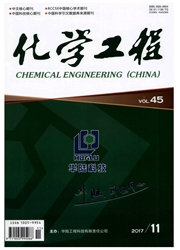

 中文摘要:
中文摘要:
对煤气化废水处理过程进行的全流程模拟结果进行了瓶颈分析,针对流程中存在的CO2残留量高导致的铵盐结晶和萃取脱酚效率低等问题,分析了各种可能的改进措施。结果表明,残留CO2主要是以离子态存在的,增加汽提塔的塔板数和调酸降低pH值都不能经济有效地降低CO2残留量,适当措施是提高汽提塔操作压力;通过增加现有脱酚萃取剂二异丙醚流量、萃取级数或降低pH值以使废水酚残留量降至400 mg/L以下都不具备工业可行性;而采用甲基异丁基甲酮(M IBK)作萃取剂可达到这一要求,并将废水中COD残留量降至4 000 mg/L左右,达到生化处理的进水要求。
 英文摘要:
英文摘要:
The bottleneck of the coal gasification wastewater treatment process was analyzed based on simulation by using Aspen Plus. The feasibility of several renovations for the two main problems, i. e. , low phenols removal performance of extraction and crystal deposition induced by the crystallization of CO2 and NH3, were discussed. The results show that it is not economical to reduce the residual concentration of CO2 by increasing the stripper stages or lowering pH of wastewater, since the residual CO2 mainly exists as ions in gasification wastewater. However, the residual concentration of CO2 can be effectively reduced by increasing the operating pressure of the stripper. It also indicates that using diisopropyl ether as solvent, the residual concentration of phenols can not be reduced to less than 400 mg/L by increasing solvent flowrate and extractor stages or lowering pH of wastewater. Based on experimental results, methyl isobutyl ketone (MIBK) can be selected as extraction solvent to meet the requirement, and the performances of phenols removal and COD removal are greatly improved for the coalgasification wastewater treatment.
 同期刊论文项目
同期刊论文项目
 同项目期刊论文
同项目期刊论文
 A novel precedence-based and heuristic approach for short-term scheduling of multipurpose batch plan
A novel precedence-based and heuristic approach for short-term scheduling of multipurpose batch plan LUBRES: An expert system development and implementation for real-time fault diagnosis of a lubricati
LUBRES: An expert system development and implementation for real-time fault diagnosis of a lubricati Cationic micelles self-assembled from cholesterol-conjugated oligopeptides as an efficient gene deli
Cationic micelles self-assembled from cholesterol-conjugated oligopeptides as an efficient gene deli A dissolution-diffusion model and quantitative analysis of drug controlled release from biodegradabl
A dissolution-diffusion model and quantitative analysis of drug controlled release from biodegradabl Solvent extraction process development and on-site trial-plant for phenol removal from industrial co
Solvent extraction process development and on-site trial-plant for phenol removal from industrial co Mesoscale simulation of drug molecules distribution in the matrix of solid lipid microparticles (SLM
Mesoscale simulation of drug molecules distribution in the matrix of solid lipid microparticles (SLM Conceptual design and system analysis of a poly-generation system for power and olefin production fr
Conceptual design and system analysis of a poly-generation system for power and olefin production fr Continuous-time approaches for short-term scheduling of network batch processes: Small-scale and med
Continuous-time approaches for short-term scheduling of network batch processes: Small-scale and med Novel Single Stripper with Side-Draw to Remove Ammonia and Sour Gas Simultaneously for Coal-Gasifica
Novel Single Stripper with Side-Draw to Remove Ammonia and Sour Gas Simultaneously for Coal-Gasifica Facile preparation of RuO2/CNT catalyst by a homogenous oxidation precipitation method and its catal
Facile preparation of RuO2/CNT catalyst by a homogenous oxidation precipitation method and its catal 期刊信息
期刊信息
